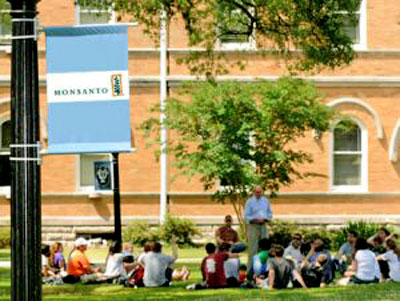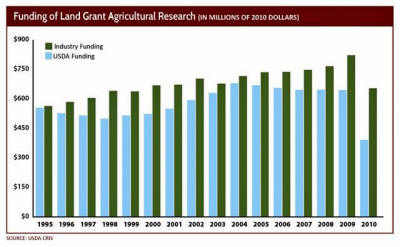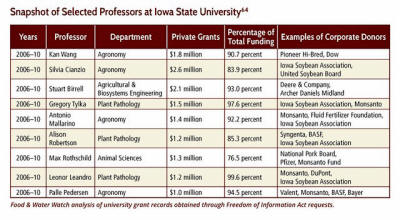|
But today, these former "land-grant"
universities have largely mutated into pro-industry, propaganda
machines funded and controlled by corporate agro-giants like
Monsanto that steer research efforts in favor of
genetically-modified (GMOs) and chemical-based crop systems.
Colleges and universities that once
received the bulk of their research funding from the federal
government now receive it from Monsanto, DuPont, and others, and
their research efforts reflect this.
...are now incubators of patented, corporate agriculture
But today, many of these land-grant colleges have essentially been taken over by private interests with little concern for anything other than their own profits.
But even the U.S. Department of Agriculture (USDA), which used to more closely represent the interests of the people, has become nothing more than a tool for promoting industry interests rather than public interests.
So whether the funding comes from the
USDA or directly from private industry, it is essentially all now
going towards the promotion of GMOs and chemical-crop systems -
little, if any, is used to develop improvements in non-GMO, organic,
and sustainable agriculture systems.
Be sure to
read below, the entire Mother Jones
piece for a more comprehensive understanding of how private
corporations are brainwashing the next generation of farmers into
embracing corporate agricultural systems.
Big Agrichemical Monsanto
May 9, 2012
The university's press release quotes Monsanto's vice president of technology communications giving a taste of its vision for the investment:
A cynic might translate that statement this way:
Monsanto's latest gift isn't its first dalliance with the prestigious college, which is located in a city surrounded by millions of acres of fields planted with Monsanto's GMO corn and soy seeds, both treated with regular doses of the company's Roundup herbicide.
Back in 2002, Monsanto donated $200,000 to ACES for the Monsanto Multi-Media Executive Studio, to be,
Nor is Monsanto the only gigantic food and ag company bestowing cash upon ACES.
A cursory look at the college's web site
turned up
a recent paper touting a novel
infant formula that "boosts babies' immunity" - funded by Nestle
Infant Nutrition and co-authored by a researcher in its employ.
It's brought to you by grants from the agribiz-aligned Illinois Soybean Association and Solae, a joint project of agrichemical giants DuPont and Bunge that calls itself,
The most remarkable thing about all of this is that it isn't remarkable at all.
A few weeks ago, I pointed to a great Chronicle of Higher Education article documenting how university animal-health research has become dominated by the pharmaceutical industry - and how the products that emerge from that process are much more about pharmaceutical industry profits than animal health.
Now there's this
eye-opening new report from Food &
Water Watch (FWW) that documents in painstaking detail how the food
and agrichemical industries have transformed our national public
agricultural research infrastructure into essentially an R&D and
marketing apparatus for their industry. (Similar trends hold for
other areas of science research, most prominently
medicine.)
And that's pretty much how things went for the first century.
It might have added that those varieties were public resources, not owned or patented by any company.
Farmers were free to save them for the
next season, and many did.
That's when food and agribusiness
companies, which were then in the process of consolidating into the
vast global enterprises we know today, began to funnel huge amounts
of cash into the land grants.
Here's FWW: And it's not only research. Just as sports franchises have turned to corporate sponsors to fund stadiums, the land grants have turned to their agribiz benefactors for building funds, FWW found.
At University of Minnesota, seed breeders toil in the Cargill Plant Genomics Building; while University of Missouri ag-science grad students attend seminars in the Monsanto Auditorium.
Iowa State undergrads lounge in the
Monsanto Student Services Wing; and food-science researchers at
Purdue can bounce between the Kroger Sensory Evaluation Laboratory
and the ConAgra Foods, Inc. Laboratory.
At Iowa State University, reps from the agribiz-aligned Iowa Farm Bureau and Summit Group, an industrial-scale producer of hogs and cows, have won seats on the governing Board of Regents.
The report brims with examples of agribiz employees occupying seats on advisory boards of various ag-related centers within the land grants. My favorite is the way the University of Georgia's Center for Food Safety forms its advisory board.
Get this, from the center's web site:
Companies that have taken the center up on its offer include,
Sometimes, compliant administrators are rewarded generously for their work.
Monsanto tapped South Dakota State University president David Chicoine for its own board of directors in 2009, FWW reports. According to Inside Higher Education, Chicoine stood to make more from Monsanto in his first year on the board than he did from his state job.
It gets better:
At some of the more prestigious schools, professors have morphed into something that looks a lot like house researchers for the agrichemical industry. Check out this snapshot from Iowa State.
Using the Freedom of Information Act, Food and Water Watch analyzed the grants received by a selection of professors between 2006 and 2010, and calculated what percentage of their grants came from private sources.
Here's what they found:
The corporate sector's generosity might be commendable if it produced research that benefitted the public as a whole - such as new open-source seed varieties that are well adapted to organic ag, or techniques for rotating cattle and crops on land that improve soil and reduce fertilizer use.
But that's not what's happening, FWW shows. Instead, the companies are funding strings-attached research that serves their own narrow interests.
The report cites numerous studies to show this, and several concrete examples like these two:
To be sure, while corporate cash has come to dominate university ag research, the USDA still funds a substantial amount of it: more than $300 million (vs. about $600 million from industry) in 2010.
In addition to its research grants for land-grant professors, the agency also employs its own scientists and maintains its own labs; its total research budget stands at about $2 billion per year.
Yet rather than act as a counterweight to the corporations, the USDA essentially mimics them.
It,
Here's a startling example: the USDA
dedicates more money to research on sweetener crops like sugar beets
($18.1 million per year) and oilseed crops ($79.4 million) than it
does to nutrition education ($15.5 million).
|



